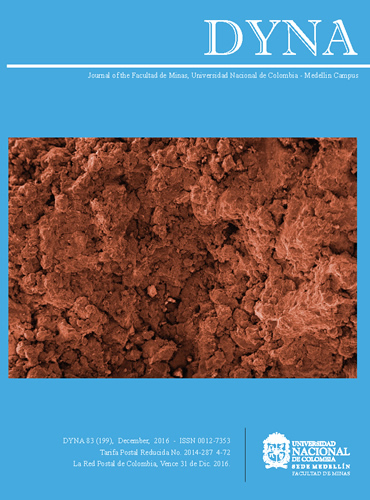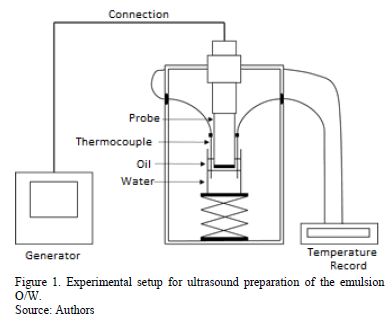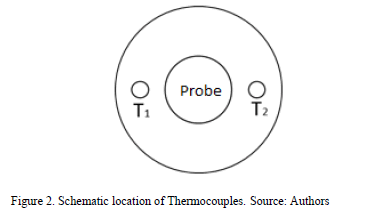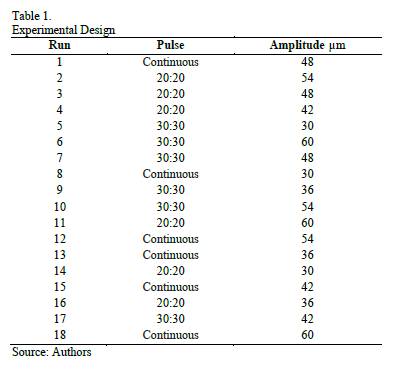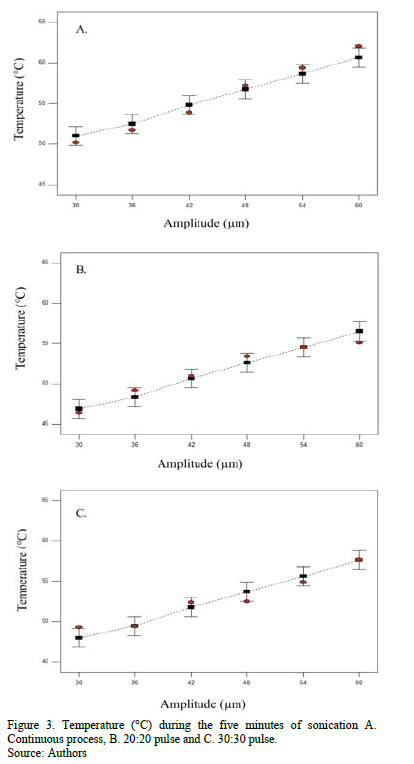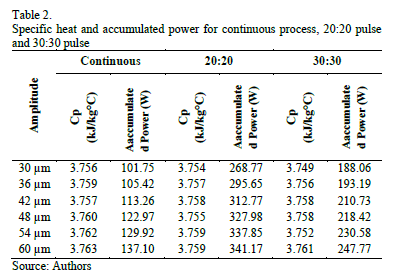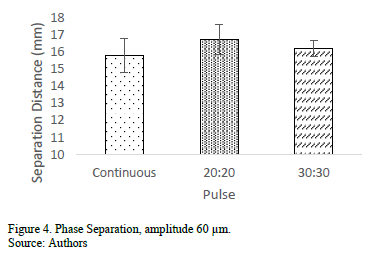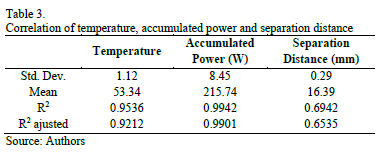Effect of amplitude and pulse in low frequency ultrasound on oil/water emulsions
Efecto de la amplitud y pulsación en ultrasonido de sonda a baja frecuencia sobre emulsiones aceite/agua
DOI:
https://doi.org/10.15446/dyna.v83n199.56192Palabras clave:
Ultrasound probe, low frequency, emulsion, pulse, amplitude, phase separation (en)Sonda de ultrasonido, baja frecuencia, emulsión, pulsación, amplitud, separación de fases (es)
Descargas
DOI: https://doi.org/10.15446/dyna.v83n199.56192
Effect of amplitude and pulse in low frequency ultrasound on oil/water emulsions
Efecto de la amplitud y pulsación en ultrasonido de sonda a baja frecuencia sobre emulsiones aceite/agua
María Alejandra Cabrera-Trujillo a, Luz Indira Sotelo-Díaz b, María Ximena Quintanilla-Carvajal a
a Maestría en Diseño y Gestión de
Procesos, Facultad de Ingeniería, Universidad de La Sabana, Campus Puente del
Común, Bogotá, Colombia. maria.cabrera1@unisabana.edu.co;
maria.quintanilla1@unisabana.edu.co
b Programa
Gastronomía. EICEA Universidad de La Sabana, Puente del Común, Bogotá,
Colombia. indira.sotelo@unisabana.edu.co
Received: March 14th, de 2016. Received in revised form: August 8th, 2016. Accepted: August 31th, 2016
This work is licensed under a Creative Commons Attribution-NonCommercial-NoDerivatives 4.0 International License.
Abstract
The application of ultrasound within advanced or emerging technologies requires selecting
parameters that depend on
the target application. This
study evaluated pulse and amplitude parameters of oil/water
emulsions (20:80% w/w)
using low frequency probe ultrasound
equipment (20 KHz). A categorical multilevel factorial design was
used with Design Expert® in
which the following pulse treatments were
defined: continuous, pulse 20:20 (on:off) and pulse 30:30 (on:off), for
five minutes. Six amplitudes (30, 36, 42, 48, 54
and 60 µm) were evaluated for the following response
variables: separation of phases
in emulsion, temperature and accumulated
power. The results
showed that the best condition to
obtain an emulsion with less phase
separation was the 20:20 (on:off) treatment with
an amplitude of 42 µm. The
ultrasound probe application
parameters that were obtained will enable
the design of stable products from low-fat emulsions.
Keywords: Ultrasound probe, low frequency; emulsion; pulse; amplitude; phase separation.
Resumen
La aplicación de ultrasonido dentro del
concepto de tecnologías avanzadas o emergentes, requiere de la selección de
parámetros según sea el objetivo de su aplicación. En esta investigación fueron
evaluados parámetros de pulsación y amplitud para mezclas aceite/agua (20:80 %
p/p), empleando un equipo de ultrasonido de sonda de baja frecuencia (20KHz).
Los tratamientos de pulsación utilizados fueron: continuo, pulsación 20:20
(on:off) y pulsación 30:30 (on:off) durante cinco minutos; se evaluaron seis
amplitudes (30, 36, 42, 48, 54 y 60 µm) sobre las variables de respuesta:
separación de fases en la mezcla, temperatura y potencia acumulada. Los resultados
obtenidos analizados por Design Expert® por medio de un diseño factorial
multinivel categórico mostraron que la mejor condición para obtener una mezcla
con menor separación, fue el tratamiento 20:20 (on:off), con una amplitud de 42
µm.Lo anterior evidencia el uso de ultrasonido de sonda como una metodología
potencial para la homogenización de mezclas.
Palabras clave: Sonda de ultrasonido, baja frecuencia; emulsión; pulsación; amplitud; separación de fases.
1. Introduction
Ultrasound is characterized by the
generation of acoustic waves, which require a medium to propagate at a rate
that is characteristic to the nature of the wave and the medium through which
it propagates [1].
Usually ultrasonic waves are classified according to the human hearing limit by
frequency ( ~20 kHz) [2-6].
Ultrasound parameters include 1) the frequency, which is defined as the number
of cycles completed by the wave per unit time  , and 2) the intensity, which is defined as the average energy
transmitted through unit area that is perpendicular to the direction of wave
propagation
, and 2) the intensity, which is defined as the average energy
transmitted through unit area that is perpendicular to the direction of wave
propagation  , where I corresponds to the
acoustic intensity (W/m2), PA is the maximum pressure (atm), r is the
density (kg/m3), and c is the wave velocity in the medium (m/s). The acoustic
power is the total energy irradiated by a source per unit time
, where I corresponds to the
acoustic intensity (W/m2), PA is the maximum pressure (atm), r is the
density (kg/m3), and c is the wave velocity in the medium (m/s). The acoustic
power is the total energy irradiated by a source per unit time  where S represents the
surface radiant area (m2), and W represents the acoustic power (W). [7].
where S represents the
surface radiant area (m2), and W represents the acoustic power (W). [7].
The effect of high power ultrasound (frequency >20 kHz) is due to wave propagation through materials of different natures, inducing compressions and decompressions of the propagation medium that generate the acoustic cavitation phenomenon. This phenomenon is transmitted through waves that compress and extend the molecular structure of the medium through which waves pass, and this cavitation generates high temperatures and pressures in the medium, generating bubbles [5,8]. Cavitation has been identified as transitory at low ultrasonic frequencies (<100 kHz) where cavitation causes the rapid growth of bubbles, leading them to collapse [7].
Low frequency and high power ultrasound (<20 kHz) is known in the food industry because it changes the physical and chemical properties of food. Different applications of ultrasound in food matrices were studied by [9-12], among which emulsification, an anti-foaming effect, microbiological inactivation, extraction, colour change, and lipid oxidation, among others, have been found. Thus, power ultrasound applications have been considered to be emerging technologies, and they are considered a green technology that offers great potential for a variety of processes [13]. One of the main uses of high-power ultrasound is the application in designing emulsions with a minimum amount of surfactant, wherein the effect depends on the characteristics of the matrix on which it is applied. For example, in the case of two immiscible liquids, if a bubble collapses near the phase boundary of the liquid, the resulting shock wave can provide a very effective mixing of the layers, causing them to require fewer surfactants and producing emulsions, with smaller drop sizes within a size distribution, i.e., producing micro or nanoemulsions, compared to other methods [6,9].
The mixing of two insoluble substances, generally oil in water, can produce emulsions as liquid-liquid dispersing systems. However, these type of emulsions constitute thermodynamically unstable systems and show phase separation or degradation due to temperature changes with phenomena such as flocculation, creaming and coalescence. The above characteristics mean that the system requires energy to disperse a liquid phase (dispersed phase) as droplets into a second phase (continuous phase) [14-17]. However, the use of ultrasound in mixtures as acoustic emulsification systems has been described by [13], in which stable particles were produced in the submicron range with a very narrow particle size distribution, permitting the use of a suitable emulsifier ratio with less energy. Thus, for the food industry, ultrasonic emulsification is of interest for the treatment of products such as fruit juices, mayonnaise, sauces, and salad dressings and for the encapsulation of aromas [6]. The effect of the power of the ultrasound on the
emulsification process was explained by M.A.T.J. Mason [8] as a process of successive disintegration that consists of two stages. In the first stage, the instability of the oil-water interface appears, as illustrated by large oil drops with a diameter of approximately 70 microns, and in the second stage, these large drops breakdown via shockwaves that are produced by cavitation bubbles. Chemat, Zill-E-Huma, and Khan [24] stated that the energy required to produce emulsions via acoustic waves is less than that needed via conventional methods that are used in mechanical emulsification, such as rotor-stator systems and high-pressure homogenizers [14].
Cárcel [7] and Peshkovsky and Bystryak [18] studied the importance of selecting different parameters, such as the frequency, wavelength, intensity, amplitude and power, for ultrasound applications to achieve more stable emulsions over time to preserve their properties and physical characteristics to scale up to the industrial level. The probe size was found to affect the intensity of the emitted wave, and this is a challenge for this technology scaling. Thus, food processing is constantly evolving, which is represented by the different challenges that the food industry should address. The evaluation of ultrasound application parameters, depending on the stability and accumulated power, is necessary to obtain stable emulsions for food applications. Thus, the aim of this study was to choose the amplitude and pulse conditions in a probe-type system for applying continuous or pulsed power ultrasound, depending on oil/water (O/W) emulsion stability, which was defined by the phase separation time.
2. Materials and methods
2.1. Materials
Borges® extra virgin olive oil, which was purchased at a local supermarket in Bogota, and type I ultrapure deionised water that had a resistance of 18.2 MW-cm (PURELAB option-Q) were used to prepare the O/W emulsions. The samples were placed in 50 ml falcon tubes.
2.2. Preparation of the O/W emulsion
The O/W emulsion (w/w) was prepared using 80% water and 20% olive oil.
2.3. Ultrasound application
Ultrasound was applied to the O/W emulsion in an ultrasound device (Qsónica®, Q700 sonicator, 700 W RMS, USA) at 20 kHz for 5 minutes via a continuous and pulsed process, this time was selected in order to avoid the overheating [19]. The ultrasound probe was placed inside a sound-reduction box whose interior walls were coated with water-resistant acoustic foam (Fig 1). A 25.4 mm titanium alloy probe with a cylindrical diameter and geometry was used. The probe was placed 10 mm below the surface of the O/W emulsion with a height of 100 mm, and the amplitudes levels were changed between 30, 36, 42, 48, 54 and 60 µm (50%, 60%, 70%, 80%, 90% and 100%, respectively) in the continuous and pulsed processes. Two pulsed treatments were applied: one 20:20 on/off and another 30:30 on/off. These treatments were performed in triplicate.
The temperature increase for the sonication time for each of the pulse and amplitude conditions was determined using two thermocouples (Digisense®) at a distance of 1 cm from the probe (Fig 1). The following fixed variables were defined: (i) Two types of pulses - continuous pulses in which the wave was transmitted without intermittence, and 20:20 and 30:30 on/off pulses in which the wave was intermittent in time. In the case of the 20:20 (on/off) pulsation, intermittency occurred for 20 seconds during which the wave propagated through the medium and for 20 seconds in which the wave stopped its propagation through the medium. For the 30:30 (on/off) condition, intermittency occurred for 30 seconds during which the wave propagated through the medium and for 30 seconds during which the wave propagation stopped [3]. (ii) Six amplitude levels (30, 36, 42, 48, 54 and 60 µm) were used for the three evaluated pulses. (iii) A sonication time of five minutes was defined as a fixed factor [20-23]
2.4. Application of ultrasound treatments
The O/W emulsion was subjected to continuous ultrasound treatment for five minutes for each amplitude. Pulse treatments of 20:20 and 30:30 on-off were performed. Each treatment was evaluated for five minutes for the chosen amplitudes. The temperature (°C) and energy (J) values were recorded for every minute.
After the pulsed or continuous sonication time, the emulsions were kept at room temperature (19 °C) forthe next three hours for the phase separation measurement.
2.5. Response variables
2.5.1. Phase separation
The time required for the phase separation was evaluated for each treatment during the three hours after sonication. A visible mark on the outer surface of the falcon tubes that contained the samples was labelled every 30 minutes, and an image was captured with a 13 Mpx camera. The images were analysed using ImageJ®.
2.5.2. Temperature record
The temperature was measured using a Digi-Sense Scanning Thermometer (model 92000-0). The temperature was recorded every minute for the continuous ultrasound, after 20 seconds in the on position for the 20:20 pulsed ultrasound, and after 30 seconds in the on position for the 30:30 pulsed ultrasound.
2.5.3. Accumulated power
The power (P) was calculated based on the power dissipated in all of the samples according to the different evaluated amplitude and pulse conditions. The calorimetric method was used for the P calculation using the ratio presented in equation (1):

where "m" is the mass of the sample (kg), Cp is the specific heat of the emulsion (kJ/kg °C), and DT/Dt is the temperature change over time (°C/s) [19]. The Cp was calculated using the method by Choi and Okos (1986). The accumulated power was calculated as the sum of the power that dissipated at each measurement point.
2.5.4. Experimental design
The effects of different pulses (continuous, 20:20 and 30:30) and amplitudes (30, 36,42,48,54 and 60 µm) were evaluated in the O/W emulsion. A multilevel categorical factorial design was performed using the statistical software Design Expert Version 9 (Statease Inc., Minneapolis, USA) to process the data. The pulsation and amplitude were the two categorical factors that were defined at different levels. Table 1 shows the experimental design in which analysis of variance (ANOVA) was performed to find significant differences for the pulses and amplitudes in the results of the phase separation. The fit of the model was evaluated using the R2 and adjusted R2 values.
3. Results and discussion
The selection of parameters as power, frequency and pulse type, helps to define the different effects that are produced by high-power ultrasound when it passes through a medium, which demonstrates their significance depending on the features of the material [6]. Therefore, the density difference between both phases under the influence of gravity leads to phase separation [25]. The following effects are described in our study: (1) the effect of amplitude on the medium temperature and phase separation, (2) the accumulated power during the sonication time, and (3) the effect of the treatment on the phase separation. As stated by Gaikwad and Pandit [26], the use of ultrasonic emulsification can be described using four characteristics: (1) a minimum intensity is required to start the emulsification process, (2) an increase in the power emitted to the matrix enhances the emulsion stability, (3) an increase in the sonication time decreases the dispersed phase droplet size, favouring the formation of microjets, and (4) the forces responsible for the emulsification are the ratio of the force acting on the droplets and the surface tension, which represent the physicochemical properties of the system.
3.1. Effect of amplitude and pulse type on temperature
The effect of different amplitudes on the temperature for each ultrasound pulse treatment was evaluated for the three types of pulse. Thus, Fig 3 shows the temperature increase during the 5 minutes of treatment for each type of pulse. This increase has been widely described by Shanmugam, Chandrapala, and Ashokkumar [26] and Pingret, Fabiano-Tixier, and Chemat [27] as being caused by the cavitation phenomenon. Thus, the ultrasound generates a strong resonance in the pulses that are represented in bubbles in the form of micro-jets, which significantly influences the acoustic environment of the liquid [29]. However, amplitude conditions are directly related to temperature increases; thus, the highest temperature was obtained in the range of 60 mmfor the pulse treatments in continuous 62°C, 20:20 pulse 55.1°C and 30:30 pulse 57.7°C. This allowed some of the acoustic energy to be degraded as heat, leading to an increase in medium temperature due to the direct relation between the temperature and the solubility of water and oil [7,30]. The pulse and amplitude were found to be significant regarding the effect of the pulses for each amplitude on the temperature (P<0.05).
Figure 3 shows that the 20:20 and 30:30 pulsed treatments have a lower temperature increase compared to the continuous treatment due to the off period of the pulsed wave effect.
3.2. Power accumulated during the sonication time
Table 2 shows the accumulated power, as calculated from equation (1). An increased accumulated power in relation to the increase in amplitude for all the pulses showed significant differences (P< 0.05) between the treatments. The 20:20 pulsed treatment with the amplitude of 60 µm accumulated the largest power during the five minutes of experimentation, which is explained by the stronger and more violent cavitation of bubble collapse in the on:off pulsation moments that generated more power. Anihouvi, Danthine, Kegelaers, Dombree, and Blecker [31] reported that cavitation is the most significant mechanism of power dissipation in a low frequency ultrasound system; thus, changes in cavitation intensity can be related directly to changes in power.
3.3. Effect of treatments on phase separation
The homogenization technology in emulsions has a relevant role in the stability of its phase, and this can be measurement as the minima distance of separation. As shown in Fig 4, the lowest phase separation occurs in the continuous treatment followed by the 30:30 pulsed treatment to 60 µm, with significant differences between them (P<0.05).
However, in relationship with the temperature smaller increases benefit O/W emulsion stability over time; nevertheless an increase in O/W emulsion temperature leads to a cavitation decrease. Therefore, it is necessary to maintain the lowest temperature possible for O/W emulsification processes, which is why the 20:20 pulsed treatment in this experiment exhibited a smaller increase in temperature of 27.4°C, 30.2°C, 32°C, 34.4°C, 35.5°C, and 36.1°C for each of the evaluated amplitudes.
3.4. Results of the correlation
Table 3 shows the correlation of the response variables, temperature, accumulated power and separation distance. We observed a high correlation with accumulated power, followed by a correlation with temperature and, finally, with the separation distance.
4. Conclusions
The use of technologies such as ultrasound to obtain O/W emulsions requires analysis of the parameters for improved application. Transient cavitation that is generated by the pulse that is related to the temperature during the emulsification process is highlighted. The relevance of the cavitation that is generated by low frequency ultrasonic waves contributes to the degradation of the acoustic energy into heat, favouring the increase in the emulsion temperature. However, smaller temperature increases that do not favour emulsion stability were found due to the accumulation of more power; thus, emulsions exhibiting less separation were obtained with continuous pulsing. This study helped to define the application parameters of ultrasound at a frequency of 20 kHz with a continuous pulse with an amplitude of 60 µm for a tip of 25.4 mm on O/W (20:80) emulsions. These results will allow the application of an advanced and emerging technology with less use of surfactants for low oil-content emulsions that can be the basis for low-fat food products. The aim of this work was to select the best conditions for emulsification, but it must be considered the formulation and the process time because shelf-life of emulsions is determined by lipid oxidation; fat/oil has an important role in determining the properties of emulsions, it influences the appearance (optical properties), sensory evaluation, texture (rheology) and stability
References
[1] Guillaume, C., Katline, L., Benoit, A.T, and Stefan, M., Changes in ultrasound velocity and attenuation indicate freezing of xylem sap, Agric. For. Meteorol., 185, pp. 20-25, 2014.DOI: 10.1016/j.agrformet.2013.10.009
[2] Canselier, J.P., Delmas, H., Wilhelm, A.M. and Abismaïl, B., Ultrasound emulsification - An overview, J. Dispers. Sci. Technol., 23(1-3), pp. 333-349, 2002.DOI: 10.1080/01932690208984209
[3] Coupland, J.N., Low intensity ultrasound, Food Res. Int., 37, pp. 537-43, 2004.DOI: 10.1016/j.foodres.2004.01.011
[4] Cárcel, J.A., García-Pérez, J.V., Riera, E. and Mulet, A., Influence of high intensity ultrasound on drying kinetics of persimmon, Dry. Technol., 25, pp. 185-193, 2007.DOI: 10.1080/07373930601161070
[5] Patist, A. and Bates, D., Ultrasonic innovations in the food industry: From the laboratory to commercial production, Innov. Food Sci. Emerg. Technol., 9(2), pp. 147-154, 2008.DOI: 10.1016/j.ifset.2007.07.004
[6] Cárcel, J.A., García-Pérez, J.V., Benedito, J. and Mulet, A., Food process innovation through new technologies: Use of ultrasound, J. Food Eng., 110(2), pp. 200-207, 2012.DOI: 10.1016/j.jfoodeng.2011.05.038
[7] Cárcel, J.A., Influencia de los ultrasonidos de potencia en procesos de transferencia de materia., Tesis Doctorado Departamento de Tecnología de Alimentos. Universidad Politécnica de Valencia. España, 2003.
[8] Mason, M.A.T.J. and Chemat, F., Power ultrasonics for food processing, Chapter 6. In Ultrasound of Food Processing. London: Blackie Academic & Professional. 1998.
[9] Mason, T., The uses of ultrasound in food technology, Ultrason. Sonochem., 3(3), pp. S253-S260, 1996.DOI: 10.1016/S1350-4177(96)00034-X
[10] Soria, A.C. and Villamiel, M., Effect of ultrasound on the technological properties and bioactivity of food: A review, Trends Food Sci. Technol., 21(7), pp. 323-331, 2010.DOI: 10.1016/j.tifs.2010.04.003
[11] Awad, T.S., Moharram, H.A., Shaltout, O.E., Asker, D. and Youssef, M.M., Applications of ultrasound in analysis, processing and quality control of food: A review, Food Res. Int., 48(2), pp. 410-427, 2012. DOI: 10.1016/j.foodres.2012.05.004
[12] Pingret, D., Fabiano-Tixier, A.S. and Chemat, F., Degradation during application of ultrasound in food processing: A review, Food Control, 31(2), pp. 593-606, 2013.DOI: 10.1016/j.foodcont.2012.11.039
[13] Gallego-Juárez, J.A., Rodriguez, G., Acosta, V. and Riera, E., Power ultrasonic transducers with extensive radiators for industrial processing, Ultrason. Sonochem., 17(6), pp. 953-964, 2010.DOI: 10.1016/j.ultsonch.2009.11.006
[14] Behrend, O., Ax, K. and Schubert, H., "nfluence of continuous phase viscosity on emulsification by ultrasound, Ultrason. Sonochem., 7(2), pp. 77-85, 2000.DOI: 10.1016/S1350-4177(99)00029-2
[15] McClements, D.J., Food Emulsions: Principles, Practices, and Techniques. New York: CRC Press, 2005.
[16] McClements, D.J., Edible nanoemulsions: fabrication, properties, and functional performance, Soft Matter, 7(6), pp. 2297-2298, 2011.DOI: 10.1039/C0SM00549E
[17] Mancinelli, R., Bruni, F., Ricci, M.A. and Imberti, S., Microscopic structure of water in a water / oil emulsion, 204503, pp. 1-8, 2013. DOI: 10.1063/1.4807601.
[18] Peshkovsky, A.S. and Bystryak, S., Continuous-flow production of a pharmaceutical nanoemulsion by high-amplitude ultrasound: Process scale-up, Chem. Eng. Process. Process Intensif., 82, pp. 132-136, 2014.DOI: 10.1016/j.cep.2014.05.007
[19] Abbas, S., Bashari, M., Akhtar, W., Li, W.W. and Zhang, X., Process optimization of ultrasound-assisted curcumin nanoemulsions stabilized by OSA-modified starch, Ultrason. Sonochem., 21(4), pp. 1265-1274, 2014 DOI: 10.1016/j.ultsonch.2013.12.017
[20] Kiokias, S., Dimakou, C. and Oreopoulou, V., Activity of natural carotenoid preparations against the autoxidative deterioration of sunflower oil-in-water emulsions, Food Chem., 114(4), pp. 1278-1284, 2009. DOI: 10.1016/j.foodchem.2008.10.087
[21] Kaltsa, O., Michon, C., Yanniotis, S. and Mandala, I., Ultrasonic energy input influence on the production of sub-micron o/w emulsions containing whey protein and common stabilizers, Ultrason. Sonochem., 20(3), pp. 881-891, 2013.DOI: 10.1016/j.ultsonch.2012.11.011
[22] Shanmugam, A. and Ashokkumar, M., Functional properties of ultrasonically generated flaxseed oil-dairy emulsions, Ultrason. Sonochem., 21(5), pp. 1649-1657, 2014. DOI: 10.1016/j.ultsonch.2014.03.020
[23] Paradiso, V.M., Giarnetti, M., Summo, C. Pasqualone, A., Minervini, F. and Caponio, F., Production and characterization of emulsion filled gels based on inulin and extra virgin olive oil, Food Hydrocoll., 45, pp. 30-40, 2015.DOI: 10.1016/j.foodhyd.2014.10.027
[24] Chemat, F., Zill, E-H. and Khan, M.K. Applications of ultrasound in food technology: Processing, preservation and extraction, Ultrason. Sonochem., 18(4), pp. 813-835, 2011.DOI: 10.1016/j.ultsonch.2010.11.023
[25] Anihouvi, P.P., Danthine, S., Kegelaers, Y., Dombree, A. and Blecker, C., Comparison of the physicochemical behavior of model oil-in-water emulsions based on different lauric vegetal fats, Food Res. Int., 53(1), pp. 156-163, 2013.DOI: 10.1016/j.foodres.2013.04.011
[26] Gaikwad S.G. and Pandit, A.B., Ultrasound emulsification: Effect of ultrasonic and physicochemical properties on dispersed phase volume and droplet size, Ultrason. Sonochem., 15(4), pp. 554-563, 2008. DOI: 10.1016/j.ultsonch.2007.06.011
[27] Shanmugam, A., Chandrapala, J. and Ashokkumar, M., The effect of ultrasound on the physical and functional properties of skim milk. Innov. Food Sci. Emerg. Technol., 16, pp. 251-258, 2012. DOI: 10.1016/j.ifset.2012.06.005
[28] Pingret, D., Fabiano-Tixier, A.-S. and Chemat, F., Degradation during application of ultrasound in food processing: A review, Food Control, 31(2), pp. 593-606, 2013.DOI: 10.1016/j.foodcont.2012.11.039
[29] Leighton, T.G., What is ultrasound?, Prog. Biophys. Mol. Biol., 93(1-3), pp. 3-83, 2007.DOI: 10.1016/j.pbiomolbio.2006.07.026
[30] Jiménez-Munguía, C.E.K.M.T., Factores principales que intervienen en la estabilidad de una emulsión doble, [En línea]. 2, pp. 1-18, 2012. Temas selectos de Ingeniería de Alimentos. Disponible en: http://web.udlap.mx/tsia/files/2013/12/TSIA-62Kosegarten-Conde-et-al-2012.pdf
[31] Leong, T.S.H., Wooster, T.J., Kentish, S.E. and Ashokkumar, M., Minimising oil droplet size using ultrasonic emulsification, Ultrason. Sonochem., 16(6), pp. 721-727, 2009.DOI.: 10.1016/j.ultsonch.2009.02.008
L.I. Sotelo-Díaz, received her BSc in Food Engineering in 1992, at the Universidad Jorge Tadeo Lozano, Bogotá, Colombia. She was Dra. in Food Science and Technology in 2000, at the Universidad Politécnica de Valencia, Spain. Is associate researcher Colciencias in Agroindustrial Process Group. She works as professor in Food science and Technology at the Universidad de La Sabana in the programs: Gastronomia, Master of Process Management and Design and Biociencias Doctorate. Her main research topics are the applications of traditional and emerging technologies in design food products and food process. ORCID: 0000-0002-6594-2539
M.X. Quintanilla-Carvajal, received her BSc in Agroindustrial Production Engineering in 2007, at the Universidad de La Sabana, Bogotá, Colombia. She was Dra. in Food Science in 2011, at the Instituto Politécnico Nacional de México. She works as professor in Agroindustrial Processes at the Universidad de La Sabana in the programs: Agroindustrial Production Engineer, Master of Process Management and Design and Biociencias Doctorate. Her main research topics are focuses on Food and Beverage, Production Engineering, Nanoprocesses (Nanoscale applications) and nanomaterials (Production and Properties). ORCID: 0000-0001-8219-7246
M.A. Cabrera-Trujillo, received her BSc in Agroindustrial Production Engineering in 2013, at the Universidad de La Sabana, Bogotá, Colombia. She is currently finishing her studies in the Master of Process Management and Design with Food Emphasis at the University of La Sabana. ORCID: 0000-0003-4178-6946
Referencias
Guillaume, C., Katline, L., Benoit, A.T, and Stefan, M., Changes in ultrasound velocity and attenuation indicate freezing of xylem sap, Agric. For. Meteorol., 185, pp. 20-25, 2014. DOI: 10.1016/j.agrformet.2013.10.009
Canselier, J.P., Delmas, H., Wilhelm, A.M. and Abismaïl, B., Ultrasound emulsification - An overview, J. Dispers. Sci. Technol., 23(1–3), pp. 333-349, 2002. DOI:10.1080/01932690208984209
Coupland, J.N., Low intensity ultrasound, Food Res. Int., 37, pp. 537-43, 2004. DOI: 10.1016/j.foodres.2004.01.011
Cárcel, J.A., García-Pérez, J.V., Riera, E. and Mulet, A., Influence of high intensity ultrasound on drying kinetics of persimmon, Dry. Technol., 25, pp. 185-193, 2007. DOI: 10.1080/07373930601161070
Patist, A. and Bates, D., Ultrasonic innovations in the food industry: From the laboratory to commercial production, Innov. Food Sci. Emerg. Technol., 9(2), pp. 147-154, 2008. DOI: 10.1016/j.ifset.2007.07.004
Cárcel, J.A., García-Pérez, J.V., Benedito, J. and Mulet, A., Food process innovation through new technologies: Use of ultrasound, J. Food Eng., 110(2), pp. 200-207, 2012. DOI: 10.1016/j.jfoodeng.2011.05.038
Cárcel, J.A., Influencia de los ultrasonidos de potencia en procesos de transferencia de materia., Tesis Doctorado Departamento de Tecnología de Alimentos. Universidad Politécnica de Valencia. España, 2003.
Mason, M.A.T.J. and Chemat, F., Power ultrasonics for food processing, Chapter 6. In Ultrasound of Food Processing. London: Blackie Academic & Professional. 1998.
Mason, T., The uses of ultrasound in food technology, Ultrason. Sonochem., 3(3), pp. S253-S260, 1996. DOI: 10.1016/S1350-4177(96)00034-X
Soria, A.C. and Villamiel, M., Effect of ultrasound on the technological properties and bioactivity of food: A review, Trends Food Sci. Technol., 21(7), pp. 323-331, 2010. DOI: 10.1016/j.tifs.2010.04.003
Awad, T.S., Moharram, H.A., Shaltout, O.E., Asker, D. and Youssef, M.M., Applications of ultrasound in analysis, processing and quality control of food: A review, Food Res. Int., 48(2), pp. 410-427, 2012. DOI: 10.1016/j.foodres.2012.05.004
Pingret, D., Fabiano-Tixier, A.S. and Chemat, F., Degradation during application of ultrasound in food processing: A review, Food Control, 31(2), pp. 593-606, 2013. DOI: 10.1016/j.foodcont.2012.11.039
Gallego-Juárez, J.A., Rodriguez, G., Acosta, V. and Riera, E., Power ultrasonic transducers with extensive radiators for industrial processing, Ultrason. Sonochem., 17(6), pp. 953-964, 2010. DOI: 10.1016/j.ultsonch.2009.11.006
Behrend, O., Ax, K. and Schubert, H., “nfluence of continuous phase viscosity on emulsification by ultrasound, Ultrason. Sonochem., 7(2), pp. 77-85, 2000. DOI: 10.1016/S1350-4177(99)00029-2
McClements, D.J., Food Emulsions: Principles, Practices, and Techniques. New York: CRC Press, 2005.
McClements, D.J., Edible nanoemulsions: fabrication, properties, and functional performance, Soft Matter, 7(6), pp. 2297-2298, 2011. DOI: 10.1039/C0SM00549E
Mancinelli, R., Bruni, F., Ricci, M.A. and Imberti, S., Microscopic structure of water in a water / oil emulsion, 204503, pp. 1-8, 2013. DOI: 10.1063/1.4807601.
Peshkovsky, A.S. and Bystryak, S., Continuous-flow production of a pharmaceutical nanoemulsion by high-amplitude ultrasound: Process scale-up, Chem. Eng. Process. Process Intensif., 82, pp. 132-136, 2014. DOI: 10.1016/j.cep.2014.05.007
Abbas, S., Bashari, M., Akhtar, W., Li, W.W. and Zhang, X., Process optimization of ultrasound-assisted curcumin nanoemulsions stabilized by OSA-modified starch, Ultrason. Sonochem., 21(4), pp. 1265-1274, 2014 DOI: 10.1016/j.ultsonch.2013.12.017
Kiokias, S., Dimakou, C. and Oreopoulou, V., Activity of natural carotenoid preparations against the autoxidative deterioration of sunflower oil-in-water emulsions, Food Chem., 114(4), pp. 1278-1284, 2009. DOI: 10.1016/j.foodchem.2008.10.087
Kaltsa, O., Michon, C., Yanniotis, S. and Mandala, I., Ultrasonic energy input influence on the production of sub-micron o/w emulsions containing whey protein and common stabilizers, Ultrason. Sonochem., 20(3), pp. 881-891, 2013. DOI: 10.1016/j.ultsonch.2012.11.011
Shanmugam, A. and Ashokkumar, M., Functional properties of ultrasonically generated flaxseed oil-dairy emulsions, Ultrason.
Sonochem., 21(5), pp. 1649-1657, 2014. DOI: 10.1016/j.ultsonch.2014.03.020
Paradiso, V.M., Giarnetti, M., Summo, C. Pasqualone, A., Minervini, F. and Caponio, F., Production and characterization of emulsion filled gels based on inulin and extra virgin olive oil, Food Hydrocoll., 45, pp. 30-40, 2015. DOI: 10.1016/j.foodhyd.2014.10.027
Chemat, F., Zill, E-H. and Khan, M.K. Applications of ultrasound in food technology: Processing, preservation and extraction, Ultrason. Sonochem., 18(4), pp. 813-835, 2011. DOI: 10.1016/j.ultsonch.2010.11.023
Anihouvi, P.P., Danthine, S., Kegelaers, Y., Dombree, A. and Blecker, C., Comparison of the physicochemical behavior of model oil-in-water emulsions based on different lauric vegetal fats, Food Res. Int., 53(1), pp. 156-163, 2013. DOI: 10.1016/j.foodres.2013.04.011
Gaikwad S.G. and Pandit, A.B., Ultrasound emulsification: Effect of ultrasonic and physicochemical properties on dispersed phase volume and droplet size, Ultrason. Sonochem., 15(4), pp. 554-563, 2008. DOI: 10.1016/j.ultsonch.2007.06.011
Shanmugam, A., Chandrapala, J. and Ashokkumar, M., The effect of ultrasound on the physical and functional properties of skim milk. Innov. Food Sci. Emerg. Technol., 16, pp. 251-258, 2012. DOI: 10.1016/j.ifset.2012.06.005
Pingret, D., Fabiano-Tixier, A.-S. and Chemat, F., Degradation during application of ultrasound in food processing: A review, Food Control, 31(2), pp. 593-606, 2013. DOI: 10.1016/j.foodcont.2012.11.039
Leighton, T.G., What is ultrasound?, Prog. Biophys. Mol. Biol., 93(1–3), pp. 3-83, 2007. DOI: 10.1016/j.pbiomolbio.2006.07.026
Jiménez-Munguía, C.E.K.M.T., Factores principales que intervienen en la estabilidad de una emulsión doble, [En línea]. 2, pp. 1-18, 2012. Temas selectos de Ingeniería de Alimentos. Disponible en: http://web.udlap.mx/tsia/files/2013/12/TSIA-62Kosegarten-Conde-et-al-2012.pdf
Leong, T.S.H., Wooster, T.J., Kentish, S.E. and Ashokkumar, M., Minimising oil droplet size using ultrasonic emulsification, Ultrason. Sonochem., 16(6), pp. 721-727, 2009. DOI.: 10.1016/j.ultsonch.2009.02.008
Cómo citar
IEEE
ACM
ACS
APA
ABNT
Chicago
Harvard
MLA
Turabian
Vancouver
Descargar cita
CrossRef Cited-by
1. C. Aguilar, J. Serna-Jiménez, E. Benitez, V. Valencia, O. Ochoa, L.I. Sotelo. (2021). Influence of high power ultrasound on natural microflora, pathogen and lactic acid bacteria in a raw meat emulsion. Ultrasonics Sonochemistry, 72, p.105415. https://doi.org/10.1016/j.ultsonch.2020.105415.
2. Ioannis Partheniadis, Rumit R. Shah, Ioannis Nikolakakis. (2022). Application of ultrasonics for nanosizing drugs and drug formulations. Journal of Dispersion Science and Technology, 43(11), p.1587. https://doi.org/10.1080/01932691.2021.1878035.
3. Noppol Leksawasdi, Siraphat Taesuwan, Trakul Prommajak, Charin Techapun, Rattanaporn Khonchaisri, Nattha Sittilop, Anek Halee, Kittisak Jantanasakulwong, Suphat Phongthai, Rojarej Nunta, Maneerat Kiadtiyot, Arisa Saefung, Julaluk Khemacheewakul. (2022). Ultrasonic Extraction of Bioactive Compounds from Green Soybean Pods and Application in Green Soybean Milk Antioxidants Fortification. Foods, 11(4), p.588. https://doi.org/10.3390/foods11040588.
4. Nahid Hassanshahi, Guangji Hu, Kenneth Lee, Jianbing Li. (2023). Effect of ultrasonic homogenization on crude oil-water emulsion stability. Journal of Environmental Science and Health, Part A, 58(3), p.211. https://doi.org/10.1080/10934529.2023.2178788.
5. Asma Tufail Shah, Mehvish Zahoor, Nawshad Muhammad, Franz Kamutzki, Johannes Schmidt, Oliver Görke. (2023). Rapid wet chemical synthesis of bioactive glass with high yield by probe sonication. Journal of Materials Chemistry B, 11(20), p.4416. https://doi.org/10.1039/D2TB02385G.
6. Ummu Busra Yavuz, Erenay Erem, Meral Kilic-Akyilmaz. (2023). Stabilization of Olive Oil in Water Emulsion with Dairy Ingredients by Pulsed and Continuous High Intensity Ultrasound. ACS Omega, 8(12), p.11425. https://doi.org/10.1021/acsomega.3c00227.
7. Shiou Xuan Tan, Hwai Chyuan Ong, Steven Lim, Yean Ling Pang. (2018). In situ reactive extraction of Jatropha curcas L. seeds assisted by ultrasound: Preliminary studies. Energy Sources, Part A: Recovery, Utilization, and Environmental Effects, 40(14), p.1772. https://doi.org/10.1080/15567036.2018.1486913.
8. Md Zakir Hussain, Sabah Khan, Barnali Sharma, Pranjal Sarmah. (2024). Multiresponse optimization of fabrication variables of α-MnO2-epoxy nanocomposite through simulation-based Taguchi-grey relational analysis. Journal of Mechanical Science and Technology, 38(12), p.6799. https://doi.org/10.1007/s12206-024-1133-6.
9. Collette Nyuydze, Sergio I Martínez‐Monteagudo. (2021). Role of soy lecithin on emulsion stability of dairy beverages treated by ultrasound. International Journal of Dairy Technology, 74(1), p.84. https://doi.org/10.1111/1471-0307.12731.
10. Lillian Maria Uchoa Dutra Fechine, Fernando Lima Menezes, Letícia Nogueira Xavier, Aldenor Souza de Oliveira, Pierre Basílio Almeida Fechine. (2021). Nanomaterials and Nanotechnology. Materials Horizons: From Nature to Nanomaterials. , p.313. https://doi.org/10.1007/978-981-33-6056-3_10.
11. Yuqing Zhang, Minfang Luo, B. Dave Oomah, Farah Hosseinian. (2024). Ultrasound-assisted food-grade double emulsion system for vitamin E and omega-3 encapsulation. Journal of Food Bioactives, , p.42. https://doi.org/10.31665/JFB.2024.18379.
12. Mónica Fernández Lozano, Diana Millan, Ronald A. Jiménez Cruz. (2024). Aporte al desarrollo de un nanogel para la liberación controlada de latanoprost. Revista Colombiana de Ciencias Químico-Farmacéuticas, 52(2) https://doi.org/10.15446/rcciquifa.v52n2.110754.
13. Saba Belgheisi, Ali Motamedzadegan, Jafar M. Milani, Ladan Rashidi, Ali Rafe. (2021). Impact of ultrasound processing parameters on physical characteristics of lycopene emulsion. Journal of Food Science and Technology, 58(2), p.484. https://doi.org/10.1007/s13197-020-04557-5.
14. Ima Wijayanti, Pornsatit Sookchoo, Thummanoon Prodpran, Chitradurga O. Mohan, Rotimi E. Aluko, Soottawat Benjakul. (2021). Physical and chemical characteristics of Asian sea bass bio‐calcium powders as affected by ultrasonication treatment and drying method. Journal of Food Biochemistry, 45(4) https://doi.org/10.1111/jfbc.13652.
15. Yen Po Wang, Shin'ichi Warisawa. (2022). Single terminal and double terminal coil shape analysis using capacitive power transmission for biomedical implant. Power Electronic Devices and Components, 3, p.100010. https://doi.org/10.1016/j.pedc.2022.100010.
16. Mitchell S.W. Lim, Thomas C.K. Yang, Yeow Hong Yap, Guan-Ting Pan, Siewhui Chong, T. Joyce Tiong. (2021). Intensification and optimisation of nickel recovery from spent hydrogenation catalysts via ultrasound-augmented hydrometallurgy. Journal of Environmental Chemical Engineering, 9(4), p.105771. https://doi.org/10.1016/j.jece.2021.105771.
17. Augustine Agi, Radzuan Junin, Mohd Zaidi Jaafar, Mohd Akhmal Sidek, Faruk Yakasai, Afeez Gbadamosi, Jeffrey Oseh. (2022). Laboratory evaluation to field application of ultrasound: A state-of-the-art review on the effect of ultrasonication on enhanced oil recovery mechanisms. Journal of Industrial and Engineering Chemistry, 110, p.100. https://doi.org/10.1016/j.jiec.2022.03.030.
18. Rajeshree A. Khaire, Bhaskar N. Thorat, Parag R. Gogate. (2022). Applications of ultrasound for food preservation and disinfection: A critical review. Journal of Food Processing and Preservation, 46(10) https://doi.org/10.1111/jfpp.16091.
19. Bingjing Zheng, David Julian McClements. (2020). Formulation of More Efficacious Curcumin Delivery Systems Using Colloid Science: Enhanced Solubility, Stability, and Bioavailability. Molecules, 25(12), p.2791. https://doi.org/10.3390/molecules25122791.
20. T. Joyce Tiong, Jin Kiat Chu, Li Yan Lim, Khang Wei Tan, Yeow Hong Yap, Umi Aisah Asli. (2019). A computational and experimental study on acoustic pressure for ultrasonically formed oil-in-water emulsion. Ultrasonics Sonochemistry, 56, p.46. https://doi.org/10.1016/j.ultsonch.2019.03.026.
Dimensions
PlumX
Visitas a la página del resumen del artículo
Descargas
Licencia
Derechos de autor 2016 DYNA

Esta obra está bajo una licencia internacional Creative Commons Atribución-NoComercial-SinDerivadas 4.0.
El autor o autores de un artículo aceptado para publicación en cualquiera de las revistas editadas por la facultad de Minas cederán la totalidad de los derechos patrimoniales a la Universidad Nacional de Colombia de manera gratuita, dentro de los cuáles se incluyen: el derecho a editar, publicar, reproducir y distribuir tanto en medios impresos como digitales, además de incluir en artículo en índices internacionales y/o bases de datos, de igual manera, se faculta a la editorial para utilizar las imágenes, tablas y/o cualquier material gráfico presentado en el artículo para el diseño de carátulas o posters de la misma revista.



